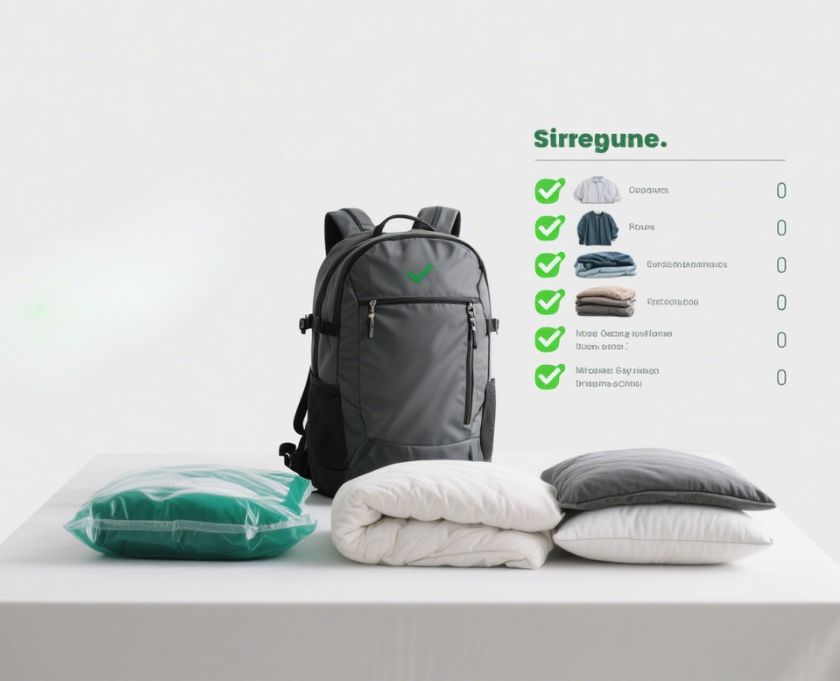Beautiful Plants For Your Interior

Vacuum compression backpacks are game-changers for travelers, digital nomads, and outdoor enthusiasts. But if you’re using one for the first time, you may be unsure what to pack—and more importantly, how to pack it right. This guide provides a complete vacuum compression backpack packing checklist tailored for first-time users, with practical tips to help you make the most of your pack’s space-saving potential.
Why Packing Right Matters in a Vacuum Compression Backpack
Unlike traditional backpacks, vacuum compression backpacks rely on airtight compartments to squeeze out excess air and reduce volume. That means packing strategy is everything. If you pack the wrong items—or pack them the wrong way—you risk damaging your gear or compromising the vacuum seal.
But don’t worry. With a clear checklist and a few smart tips, even first-time users can master this minimalist packing method.
✅ Essential Items to Pack
These are the items you should include in your vacuum compression backpack, especially if you’re preparing for a trip of 3–10 days.
1. Lightweight, Wrinkle-Resistant Clothing
- Quick-dry t-shirts (2–3)
- Travel pants or leggings (1–2)
- Merino wool base layers (ideal for both warm and cold climates)
- Underwear and socks (3–5 pairs)
Pro Tip: Roll your clothes instead of folding them for better compression and fewer wrinkles.
2. Compact Outerwear
- Packable down jacket or windbreaker
- Lightweight rain poncho
These are perfect for vacuum compression due to their compressible material. Make sure they’re dry before sealing to prevent mildew.
3. Travel-Sized Toiletries
- TSA-approved toiletry bag
- Solid shampoo and soap bars
- Refillable travel bottles (under 100ml)
Avoid bulky toiletry kits. Opt for minimalist, leak-proof containers to reduce both size and risk of spills.
4. Small Electronics & Accessories
- Power bank
- Travel adapter
- Phone + charger
- E-reader or tablet
Wrap cables with Velcro ties and store them in a small zip pouch. Keep fragile electronics outside the compressed compartments to avoid pressure damage.
5. Important Documents (in Non-Compressed Section)
- Passport
- ID
- Travel insurance papers
- Emergency contacts
Never place official documents in the compressed area; the pressure may bend or damage them.
❌ Items to Avoid Packing in a Compression Section
Refer to our related article: What Not to Pack in a Vacuum Compression Backpack: Avoid These 7 Items for a full breakdown. But in short, avoid:
- Hard objects (can damage the seal)
- Wet or damp clothes
- Food items
- Sharp tools
- Fragile electronics
🧳 First-Time Packing Tips: Make It Efficient
1. Separate Items by Use
Use packing cubes or ziplock bags to separate clothes, toiletries, and tech. This keeps the bag organized and reduces time spent digging around.
2. Distribute Weight Evenly
Place heavier items at the bottom and lighter items toward the top. This ensures comfort and balance when wearing the backpack for long hours.
3. Leave Room for Expansion
Compression is great, but don’t overstuff. You may need space to re-pack quickly or add souvenirs on the return trip.
4. Pre-Test at Home
Before your actual trip, do a trial run:
- Pack the bag fully
- Use the vacuum feature or air valve
- Carry it around for 30 minutes
This test helps you identify discomfort or issues with access and organization.
📝 Printable Packing Checklist for First-Time Users
| Category | Items |
|---|---|
| Clothing | T-shirts (3), Pants (2), Underwear (5), Socks (5), Jacket (1) |
| Toiletries | Solid shampoo, Soap, Toothbrush, Travel-sized toothpaste |
| Electronics | Phone, Charger, Power bank, Adapter |
| Documents | Passport, ID, Travel insurance, Boarding pass |
| Miscellaneous | Pen, Ziplock bags, Foldable shopping bag, Sunglasses |
You can customize this list based on trip length, destination weather, and personal preferences.
🛠 Tools to Maximize Compression Efficiency
If your vacuum compression backpack includes a pump, use it after sealing to remove excess air. Some models also have built-in air valves—just roll the bag to push air out manually. Make sure:
- The zippers are airtight
- The fabric is not folded near the seal
- The pump nozzle fits snugly (if applicable)
⚠️ Common Packing Mistakes First-Timers Make
Avoid these errors to ensure smooth travel:
- Overpacking: Remember, just because it compresses doesn’t mean you should bring more.
- Forgetting weight limits: Airlines still weigh bags—even compressed ones.
- Ignoring weather conditions: Packing only light clothes for a colder destination is a rookie mistake.
- Mixing wet and dry gear: Damp clothes can cause mildew and odor.
- Compressing fragile items: This may damage electronics or leak containers.
Final Thoughts: Travel Smart with Your Vacuum Compression Backpack
First-time packing can feel overwhelming—but it doesn’t have to be. By following this vacuum compression backpack packing checklist, you’ll avoid rookie mistakes, stay organized, and travel lighter than ever before.
Your backpack isn’t just a bag; it’s your travel system. And when used properly, it can transform the way you move—whether you’re crossing cities, mountains, or continents.